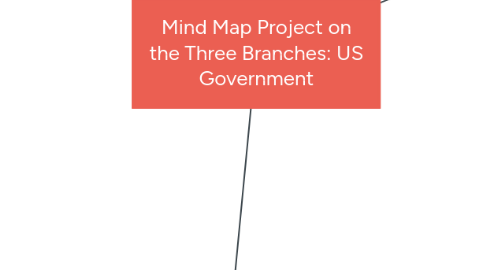
1. The Legislative Branch
1.1. Article One of the United States Constitution establishes the Legislative Branch
1.2. House of Representatives and The Senate are the chambers of Congress
1.2.1. H.O.R:
1.2.1.1. Must me 25 years old
1.2.1.2. Citizen in the US for 7 years
1.2.1.3. Resident of the state you represent
1.2.1.4. Has a total of 435 members
1.2.1.5. Term limit is 2 year but are considered for reelection every even year.
1.2.2. Senate
1.2.2.1. Must be at least 30 years old
1.2.2.2. Citizen in the US for 9 years
1.2.2.3. Live in the state you represent
1.2.2.4. Has a total of 100 members
1.2.2.5. Term limit is 6 years but elections of Senates are staggered over even years
1.3. Powers of Branch (expressed powers)
1.3.1. Makes all laws
1.3.2. declares war
1.3.3. regulates interstate and foreign commerce
1.3.4. controls taxing and spending policies
1.3.5. Ratifies treaties
1.3.6. Can impeach or remove the president or judges if a crime has been committed
1.3.7. Over rides President veto
1.3.8. Also can proposed amendments to overrule a judicial decisions
2. The Executive Branch
2.1. Qualification
2.1.1. President
2.1.1.1. must be a natural born citizen of the United States
2.1.1.2. resident for 14 years,
2.1.1.3. 35 years of age or older
2.1.2. Vice President
2.1.2.1. must be a natural born citizen of the United States
2.1.2.2. resident for US for 14 years
2.1.2.3. 35 years of age or older
2.2. Terms
2.2.1. Term length for a president and vice- president is 4 years
2.2.2. The term limit for both is 2 years
2.3. Powers of Branch (Implied Powers)
2.3.1. Being able to veto, or reject, a proposal for a law.
2.3.2. Appoint federal posts, such as members of government agencies.
2.3.3. Negotiate foreign treaties with other countries
2.3.4. Appoint federal judges.
2.3.5. Grant pardons, or forgiveness, for a crime.
2.4. Role of the President
2.4.1. acts as head of state and Commander-in-Chief of the armed forces
2.4.2. responsible for implementing and enforcing the laws
2.4.3. appoints the heads of the federal agencies, such as the Cabinet.
2.4.4. sign legislation into law or to veto bills enacted by Congress
2.4.5. Can negotiate and sign treaties but also have to be ratified by two-thirds of the Senate
2.4.6. Can extend pardons and clemencies for federal crimes
2.5. Number of Executive Departments plus their names
2.5.1. Total of 15 Executive Departments
2.5.1.1. Department of State
2.5.1.2. Department of the Treasury
2.5.1.3. Department of Department of Defense
2.5.1.4. Department of Justice
2.5.1.5. Department of the Interior
2.5.1.6. Department of Agriculture
2.5.1.7. Department of Commerce
2.5.1.8. Department of Labor
2.5.1.9. Department of Health and Human Services
2.5.1.10. Department of Housing and Urban Development
2.5.1.11. Department of Transportation
2.5.1.12. Department of Energy Education
2.5.1.13. Department of Homeland Security
2.5.1.14. Department of Energy
2.5.1.15. Department of Veterans Affairs
2.6. Article Two of the United States Constitution establishes the Executive Branch
3. The Judicial Branch
3.1. Article Three of the United States Constitution establishes the Judicial Branch of the federal government
3.2. Qualification
3.2.1. Appointed by the president then approved by the Senate
3.2.1.1. No age, education, job experience, or citizenship rules exist is really required as they do for H.O.R and the Senate
3.3. How a member of Supreme Court selected
3.3.1. President appoint someone for a vacancy on the Court and the Senate approved the nominee
3.4. Nine Justices make up the current Supreme Court
3.5. Title of the Head of Justices is The Attorney General
3.6. Supreme Court justices have life sentences unless they...
3.6.1. they die
3.6.2. resign/ retire
3.6.3. impeached and removed from office.
3.7. Powers
3.7.1. declares Executive Actions and orders unconstitutional
3.7.2. Judicial Review
3.7.3. Can declare acts of Congress unconstitutional
3.7.4. main power is to exercise ultimate appellate jurisdiction over all federal and state cases
